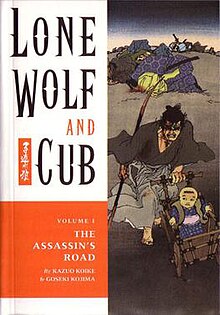
Back Ensom Ulv og Hvalp Danish Lone Wolf & Cub German Kozure Ōkami Spanish گرگ تنها و توله Persian Lone Wolf and Cub Finnish Lone Wolf and Cub French Kozure Ookami ID Lone Wolf and Cub Italian 子連れ狼 Japanese 아들을 동반한 검객 Korean
| Lone Wolf and Cub | |
 Cover art by Frank Miller of Lone Wolf and Cub vol. 1 (English version), featuring Ogami Ittō (top) and Daigorō (bottom) | |
| 子連れ狼 (Kozure Ōkami) | |
|---|---|
| Genre | |
| Manga | |
| Written by | Kazuo Koike |
| Illustrated by | Goseki Kojima |
| Published by | Futabasha |
| English publisher | |
| Magazine | Weekly Manga Action |
| Demographic | Seinen |
| Original run | September 10, 1970 – April 1, 1976 |
| Volumes | 28 |
| Sequels | |
| |
Lone Wolf and Cub (Japanese: 子連れ狼, Hepburn: Kozure Ōkami, "Wolf taking along his child") is a Japanese manga series created by writer Kazuo Koike and artist Goseki Kojima. It was serialized in Futabasha's Seinen manga magazine Weekly Manga Action from September 1970 to April 1976, with its chapters collected in 28 tankōbon volumes. The story was adapted into six films starring Tomisaburo Wakayama, four plays, and a television series starring Kinnosuke Yorozuya, and is widely recognized as an important and influential work.[3]
Lone Wolf and Cub chronicles the story of Ogami Ittō, the shōgun's executioner who uses a dōtanuki battle sword. Disgraced by false accusations from the Yagyū clan, he is forced to take the path of the assassin. Along with his three-year-old son, Daigorō, they seek revenge on the Yagyū clan and are known as "Lone Wolf and Cub".
Lone Wolf and Cub is considered to be among the most influential manga ever created.[4] It has been cited as the origin for the trope of a man protecting a child on a journey across a dangerous landscape. This is known as the Lone Wolf and Cub trope or genre, which has since inspired numerous books, comics, films, television shows and video games.[5][6][7]
- ^ Cite error: The named reference
Vol12was invoked but never defined (see the help page). - ^ O'Rourke, Shawn (January 20, 2010). "Lone Wolf and Cub Part 2: Revenge in the Epic Narrative Tradition". PopMatters. Archived from the original on October 30, 2020. Retrieved September 22, 2021.
- ^ Bernardin, Marc (July 19, 2002). "Father Knows Best". Entertainment Weekly. Archived from the original on December 29, 2019. Retrieved November 18, 2019.
- ^ Cite error: The named reference
animenationwas invoked but never defined (see the help page). - ^ Cite error: The named reference
slashfilmwas invoked but never defined (see the help page). - ^ Cite error: The named reference
hollywoodreporterwas invoked but never defined (see the help page). - ^ Cite error: The named reference
mashablewas invoked but never defined (see the help page).